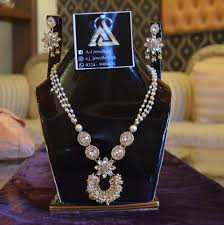How To Clean And Polish Your AJ Jewelry
AJ Jewelry is founded in 2015 by Alanoud & Aljazi Althunayan. The company took off shortly after its first fine jewelry piece was released. The first gold and diamond bracelet went on sale right away.In order to keep up the momentum, the two female entrepreneurs participated in direct-to-consumer luxury events and pop-up stores in Riyadh, Khobar, and Jeddah, quickly establishing a network of followers as well as high profile clients and media recognition.. The designs are inspired by their surroundings, the undulating dunes, the starry desert sky and the architecture of their town. For its timelessness, wearability, and rich patina, 18-carat gold is their material of choice. The sisters insist that their jewelry is practical, playfully stacked, mixed, matched, and collected, and that it is designed for everyday wear. Their goal is to redefine how a new generation wears fine jewellery.
DISCOVERING AJ JEWELRY
If you are looking for a way to ensure that art fuels imagination and creativity, then AJ Jewelry is the perfect choice. The brand was founded in May 2015 by Alanoud and Aljazi Althunayan as a tribute to their passion for jewelry and as a result of their traditional family values of gifting and passing down jewelry as a symbol of love and support. The two Saudi jewelry designers come from a family that enjoys visiting galleries and museums worldwide. They add their modern flair to the marvels they create, and therefore speak to a younger generation. It would be impossible to forget the charm of their first fine jewelry piece, the bar bracelet, which sold out immediately upon its release, or their signature stacking bracelets available in rose, yellow or white gold micro-set with diamonds.
Materials And Methods
Gemstones, coins, and other precious items are often used in making AJ Jewelry, and they are usually set in precious metals. From 900 (90% pure) to 950 (95% pure), platinum alloys are available. AJ Jewelry typically uses sterling silver, or 92.5% fine silver. Sometimes, stainless steel findings are incorporated into costume jewellery. Other materials commonly used to create jewellery include glass, which can be fused or enameled; wood, which can be carved or turned; shells and other natural animal materials such as bone and ivory; natural clay; and polymer clay. Hemp and other twines have also been used to create jewellery with a more natural feel. As long as there is lead in the piece, or lead solder, the British Assay Office (the agency that gives U.K. AJ Jewelry its stamp of approval, the Hallmark) will be able to destroy the piece, although this is extremely rare.
Impact On Society
AJ Jewelry has been used to indicate status. Rings were reserved for certain ranks in ancient Rome; later, sumptuary laws determined which type of jewellery could be worn by certain people. At that time, rank determined what type of jewellery could be worn. Culture was also a major factor. During the 19th century and early 20th century, wearing earrings by a Western man was considered effeminate. Some groups have accepted the display of body AJ Jewelry, such as piercings, as a badge of courage, while others have rejected it. Additionally, hip hop culture has popularised the slang term bling-bling, which refers to ostentatious displays of AJ Jewelry by men and women alike. AJ Jewelry in the early 20th century, on the other hand, launched a campaign to popularize wedding rings for men, which caught on, as well as engagement rings for men, which did not, even going so far as to say that the practice had medieval origins. The use of double rings at weddings increased dramatically from 15% in the 1920s to 85% in the mid-1940s.[19] Some religions have specific rules or traditions surrounding jewellery (or even banning it), and many others have edicts prohibiting excessive display. Islam, for instance, considers men’s wearing of gold as Haraam. [20] Most Islamic jewellery was dowries and was not handed down from generation to generation, but was instead discarded at the souk or sold to passersby after a woman’s death. Islamic AJ Jewelry from before the 19th century is extremely rare.

